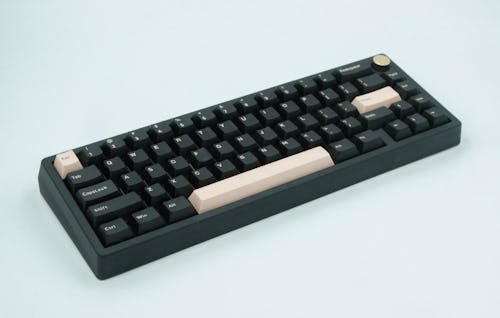
Building your first mechanical keyboard can be a daunting endeavor. You have to find a keyboard, keycaps, switches, stabilizers, maybe even lube, foam, and a fancy cable. And until you’ve collected all of these components and put them together, you have no clue whether they’ll even make a good keyboard in the end.
Meletrix’s latest keyboard — the Zoom65 — makes it so you don’t have to hope that your components will work well together. Instead, they do all the hard work of picking components for you. All you have to do is put it together and type.
The Zoom65 is a 65 percent gasket-mounted mechanical keyboard with a full-aluminum case, brass-colored highlights, a rotary encoder, and full programmability. The keyboard also includes a coiled cable, a carrying case, and a few tools for assembly.
Retailing for $180, the Zoom65 sits comfortably in the same price range as Razer’s Huntsman V2 and Corsair’s K100. The keyboard is regularly restocked by Meletrix in both the light and dark colorways. Along with this, Meletrix has recently announced that the Zoom65 will be sold in a Essential Edition, which will offer the case and a Bluetooth PCB in multiple colors with no keycaps or switches for $160.
Input may receive a portion of sales if you purchase a product through a link in this article. We only include products that have been independently selected by Input's editorial team.
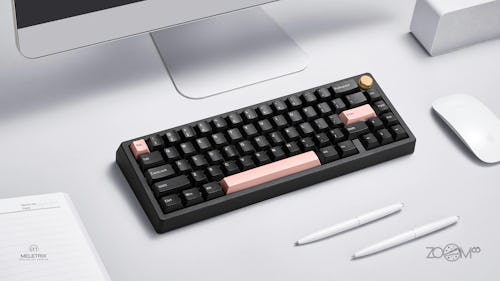
Build experience
One of the many joys of a premium mechanical keyboard is the building experience. You get to know your keyboard inside and out, understanding what it’s made of and how everything works. Essentially, it’s like a Lego set for computer nerds.
Building the Zoom65 is a straightforward and enjoyable experience. Almost all of the necessary tools are included, and assembling the keyboard is super easy — but not so easy that I’d recommend trying it without instructions.
The gasket-mounting system is consistent, and seeing the assembly come together is super satisfying — what was once a pile of parts on your desk becomes a premium typing machine. Once the keyboard is fully assembled, you’ll have the same end-product satisfaction as a custom-built PC or a Gunpla model. (Ikea effect, anyone?)
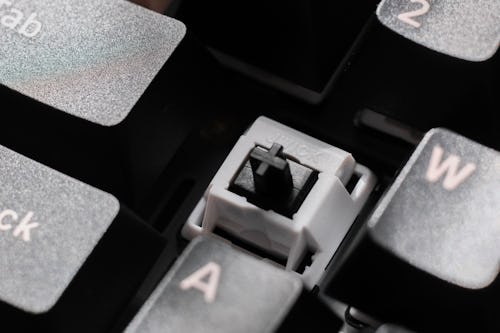
While some building is required, the Zoom65 avoids the most tedious part of building a keyboard: switch tuning. The JWK Linear switches included are pre-lubed and feel fantastic, which means you won’t have to open up each switch and apply lube by hand with a brush. While this can be fun at first, it takes forever to do, and often ends up being my least favorite part of building a keyboard.
In addition, almost all of the necessary components are included: gaskets, screws, foam, even two little allen wrenches for the hex screws. The only things you need to provide are a Phillips-head screwdriver to install the stabilizers and lube to tune them (and if you’re getting into keyboards, you’ll want to have both of those on-hand anyways).
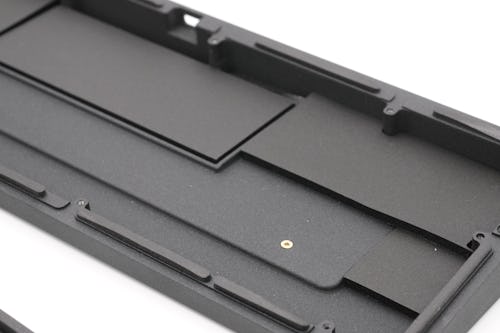
The main issue I ran into was that, at times, the assembly order wouldn’t make sense: you can’t put the switches into the PCB unless they're removed from the case, but you can't install the PCB into the case while all of the switches are installed. Instead, you have to install most of the switches, assemble the keyboard, and then install the remaining few.
Along with that, the flex cuts in the polycarbonate plate and PCB mean that putting switches into the keyboard can be difficult at times — the plate can bend instead of letting the switches click in, and it isn't easy to seat the switches into the PCB’s hot-swap sockets unless the entire keyboard is disassembled.
However, all of these issues are almost entirely down to the initial learning curve, and likely won't present any problem when swapping out components as long as you’re careful when assembling.
There are some clever design choices on the Zoom65 as well: The case foam is separated into two layers, so you can adjust the amount of foam in the case to match how loud you want your keyboard to sound. Along with that, the Zoom65 takes advantage of its hot-swap sockets to include a sheet of foam that goes between the switches and the PCB. While a soldered board would prevent this sheet from being used, as it would run the risk of melting and damaging the components, a hot-swap board means that it can be used and, as a result, the sound signature can be more unique than your average mechanical keyboard.
High-quality build
While the Zoom65 doesn’t compare to some ultra-high-end keyboards like the 7V, TGR Jane, or the Mode SixtyFive — the aluminum doesn’t have a super-smooth finish, the badge is anodized aluminum instead of brass, and the PCB isn’t particularly thick — it’s still incredibly well-made, and blows almost every sub-$200 pre-built keyboard out of the water.
Primarily, this is because the Zoom65 is designed to hide its shortcomings. Both halves of the case are made from aluminum, and they have a textured, sparkly outer finish applied that both feels premium and covers up any marks left from the machining process. Along with that, the inclusion of countless different types of foam (plate and case foam, soft foam gaskets, and a sheet of switch foam which goes between the switches and PCB) all mean you can fine-tune the typing sound to your personal preferences.
Even with its shortcomings, the Zoom65 does a lot of things right: The PCB feels durable without being too thick to flex, the plate is made from polycarbonate, and the rotary encoder has a satisfying, weighty click as it rotates — one that’s leagues better than keyboards like the MSI GK71 Sonic.
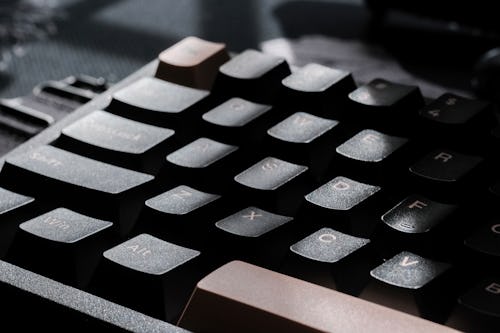
The keycaps are fairly thick double-shot PBT featuring the same colorway as the sought-after GMK Olivia. While they aren’t at the same level of quality as a GMK set (which should be obvious, considering a set of GMK keycaps costs almost as much as the Zoom65), they’re still really high-quality, create a satisfying typing sound, and will practically last forever.
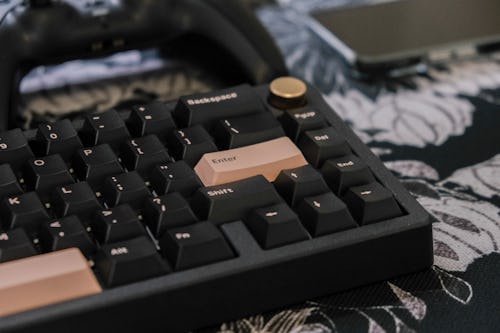
It is worth noting that the brass-colored details on the Zoom65 — the badge on the bottom and the dial at the top right — are both made from anodized aluminum instead of actual brass. While this feels a bit less premium, the difference isn’t noticeable unless you’re used to keyboards with real brass components (however, the Essential Edition of the Zoom65 will have options for a brass dial and a stainless steel weight).

Along with the keyboard itself, the Zoom65 package comes with some nice accessories: A branded carrying case that’s similar to the ones offered with high-end keyboards like the Mode SixtyFive, a switch puller with a beautiful multicolored anodization, and a high-quality coiled cable. While none of these directly improve the keyboard’s typing experience, it makes the inexpensive price tag feel even more like a bargain than it already was.
Superb typing
Once the keyboard is built, the foam is installed, and the stabilizers are tuned, this keyboard both sounds and feels great to type on. The sound profile is light and poppy thanks to the polycarbonate plate and lubed switches, and the key feel is smooth without any effort.
The switches themselves are recolored and pre-lubed JWK switches — a smooth, inexpensive mechanical switch that’s become popular in mechanical keyboard communities over the past couple of years. As a budget option, they’re smooth, consistent, and comfortable. More than anything, they help to create the keyboard’s fantastic “pop-y” sound signature.
As for the keyboard itself, the typing experience is soft and responsive thanks to both the foam gaskets being used to hold the plate and PCB in place, and the horizontal flex cuts in both the PCB and plate. Pressing the keys all the way down results in a softer bottom-out, since the entire keyboard flexes to absorb the force of the keypress. This compares to the more rigid bottom-out feel of a traditionally-mounted keyboard, where pressing a key all the way down results in little flex and instead feels much more solid.
While the typing feel likely isn’t for everyone — I know many typists prefer a more solid and robust typing feel — the keyboard’s flex creates a more relaxed and comfortable typing experience, as opposed to the rigid feel many keyboards have. To me, this can be better for long writing sessions, since typing on a flexible keyboard feels less strenuous than a solid keyboard (although I’m sure it’s almost entirely psychological).
Overall, I only have one definitive issue with this keyboard: The case’s edges sit a tiny bit too high and I often find my thumb bumping against the edge of the case while hitting the spacebar. While I was able to adjust to this over time, it’s still fairly irritating, and I found myself bumping my thumb against the bottom of the case whenever I returned to the Zoom65 after using another keyboard for a while.
Dubious longevity
While the Zoom65 may feel great to type on immediately after being built, I have some concerns about its long-term usability. Primarily, some of the materials that create the Zoom65’s soft, relaxed typing feel are — expectedly — soft. The gaskets, instead of being made from a more rigid rubber material, are made from strips of soft foam. While these can create a soft typing feel with a lot of flex, I worry that they could end up either hardening or crumbling over time, leaving the keyboard less enjoyable to type on or even completely unusable.
The Zoom65 has a premium typing feel that’s well above its price tag.
Similarly, the keyboard’s PCB and plate have “flex cuts” which allow them to flex more when typing. These feel great to type on, and most keyboard designers who produce components with flex cuts say that they have tested them to ensure their long-term durability, but there is still a slight concern that they won’t hold up under heavier use or that assembling and disassembling the keyboard multiple times (making use of the hot-swap switches) could put undue wear onto the flexible components, resulting in cracking, breaking, or the loosening of solder joints.
Along with that, the switches’ housings aren’t the most durable. When trying to take the switches out using the included switch remover, I ended up snapping the plastic on at least two of them. This didn’t break the switches, but I do worry that too many of the switches’ housings breaking could make it difficult to remove them.
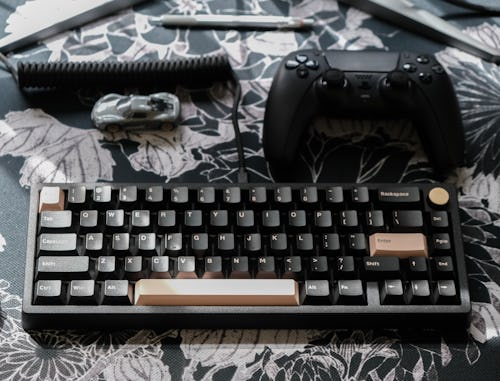
However, considering the widespread accessibility of this keyboard, its mass-production-ready design, and how common design choices like flex cuts are in the custom keyboard community, I doubt that these issues are anywhere as severe as I make them sound here. Instead, they’re just concerns over the long-term usability of the product. I would anticipate that Meletrix tested these things and found that the keyboard will hold up over time, but when I reached out to the company asking about these concerns, I received no response.
A great “budget” custom
While you might scoff at the idea of a $200 keyboard being a budget offering, it’s not completely absurd within the custom keyboard space. Many premium keyboards sell for well above $400, and some even fetch almost $1,000 once they’ve been fully outfitted with everything you need. By comparison, a $200 keyboard is a really good price.
However, that $200 price tag is only good if the typing experience matches. And from the testing I’ve done, the Zoom65 has a premium typing feel that’s well above its price tag. The keyboard isn’t as refined as a board like the Mode SixtyFive, it’s a better typing experience than similarly priced offerings from companies like Razer, MSI, and Corsair (but if you’re looking for RGB lights, then I’d suggest looking at those — this keyboard only has one LED for the caps lock key).
Overall, the Zoom 65 mechanical keyboard is stylish, comfortable, and utilitarian. It isn’t the highest-end option, but it isn’t trying to be that either. Instead, it’s a fantastic way to test the waters with a premium keyboard without spending an absurd amount of money.
The only issue right now is that the Zoom65 sells out incredibly quickly whenever Meletrix restocks them. If you really want to get your eyes on one, you’ll definitely want to keep a lookout.




!["[T]he First and Fifth Amendments Require ICE to Provide Information About the Whereabouts of a Detained Person"](https://images.inkl.com/s3/publisher/cover/212/reason-cover.png?w=600)


